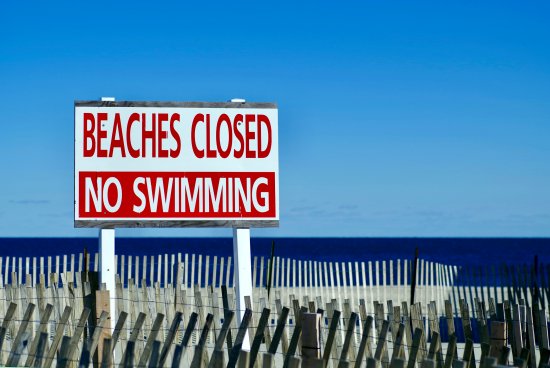
High bacteria levels might throw a wrench in your holiday plans. Here are the risks and how to stay safe.
The Fourth of July holiday can often be a great opportunity to visit the seaside for a sandy getaway. But local governments across the U.S. have issued warnings and closures to stay away from certain shores due to alarmingly high bacteria levels.
As of Monday afternoon, at least 29 beaches in Massachusetts have been reported closed due to “bacterial exceedance,” according to the state’s Department of Public Health Beach Water Quality Dashboard.
In California’s San Diego County, one beach in the Coronado area has been closed since May as “bacterial levels exceed health standards,” according to its Department of Environmental Health and Quality’s Beach and Bay Water Quality Monitoring Program.
[time-brightcove not-tgx=”true”]In New York’s Nassau County, Crescent Beach has been closed for swimming as of Monday evening due to high levels of enterococci bacteria found in samples.
Michigan’s Department of Environment, Great Lakes and Energy also reports that four beaches have been closed since last week, due to high bacterial levels.
How should I interpret beach closures?
The U.S. Centers for Disease Control and Prevention advises those planning to visit the beach to heed closures and to stay out of closed bodies of water, as they are “unsafe” for swimming.
And even if a beach or lake is not technically closed, if the water smells bad or looks discolored or cloudier than usual, there could be harmful contaminants in it. Those with open wounds are especially advised to stay away.
What bacteria has been found in beaches?
While officials have not clarified the bacteria present in the beaches in California and Michigan, Massachusetts officials monitor levels of enterococci or E. coli—called indicator organisms—to determine “bacterial exceedance.”
Enterococci and Escherichia coli, according to the U.S. Environmental Protection Agency (EPA), are bacteria that live in the intestines of warm-blooded animals like humans. While enterococci and most strains of E. coli are typically not considered harmful to humans, their presence in water can indicate possible contamination by fecal waste and may also signal that other disease-causing pathogens, such as viruses, bacteria, and protozoa, may also be present in the water.
Two Massachusetts beaches also cite “harmful cyanobacteria bloom” for their closures as of Monday night. The EPA says these cyanobacteria—also called blue-green algae—are often identified as “floating mats of bad-smelling, decaying and gelatinous scum in lakes” that are usually green in color.
How harmful are these bacteria?
When cyanobacteria degrade, they may release toxins that could be harmful to humans, the EPA says. Severe effects of cyanobacteria exposure are rare, but it can cause allergic reactions such as skin rashes, eye irritations, respiratory symptoms. In some cases it can cause gastroenteritis, liver and kidney failure or death.
The EPA says those who swim or come in contact with water with elevated levels of E. coli and other fecal indicator organisms are at an increased risk of getting sick because of potential exposure to fecal pathogens. Common symptoms of ingesting a harmful strain of E. coli include vomiting and diarrhea. Enterococci, meanwhile, is a common cause in hospitals of urinary tract infections, according to the National Institutes of Health, and are highly resistant to antiseptics and antibiotics. Some enterococci, of which there are more than 50 different species, are also linked with more serious diseases like endocarditis and peritonitis.
What are other reasons for beach closures?
Bacteria isn’t the only cause of beach closures. The National Ocean Service says other common causes can include excessive rain that carries pollutants from storm drains to recreational bodies, harmful “algal blooms” such as “red tides,” and sewage or chemical spills.
Several beaches in Florida, Hawaii, and California have also been closed at various points this year following shark sightings or attacks.
In general, according to the Woods Hole Oceanographic Institute, the best things to do are plan ahead for trips to the beach and monitor advisories, look out for swim spots that have good water circulation, and practice basic hygiene, including washing with clean water and soap after swimming.